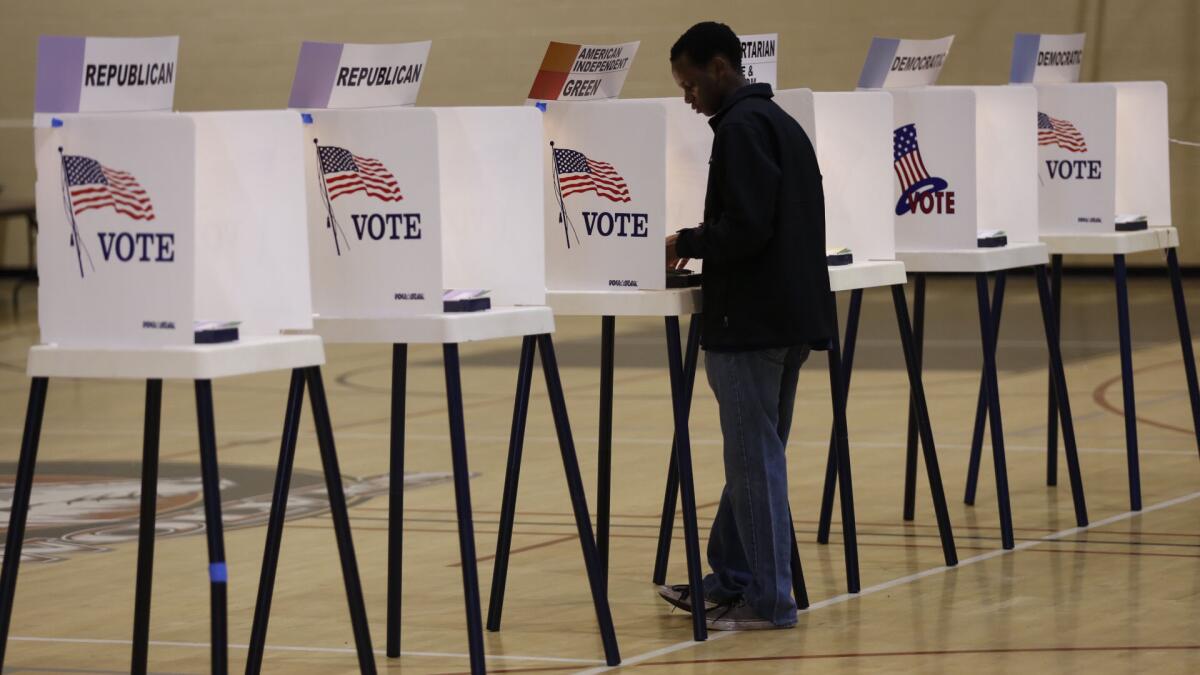Voters choose state candidates amid record special interest spending

Reporting from Sacramento â In a year when interest groups spent a record amount of money in legislative elections, California voters were sorting through an array of candidates to determine whom they want to represent them in the Capitol.
Many of the campaigns have hinged on what kind of Democrat is the best fit for each district, a question that has taken on increased prominence as the Republican Party continues to fade in the state.
Independent expenditures by oil companies, education advocates, unions and other groups reached nearly $29 million during the primary, according to the nonpartisan Target Book, which tracks California elections. The total far outstripped the $16.7 million in spending two years ago.
In several races, outside groups spent much more money than the candidates themselves.
Democrats are two seats short of a two-thirds supermajority in the Assembly and one seat short in the Senate. If they cross that threshold, they can approve new taxes and fees without Republican votes.
It was too early to tell Tuesday night whether Democrats have a solid chance at supermajorities in Novemberâs general election. But even if they achieve that goal, the primary has been a reminder of divisions with the party.
In some battles among Democrats, education advocates funded by wealthy donors faced off with Californiaâs most powerful teachers union. In other races, oil companies and environmentalists were at odds.
The stateâs open primary system allows the top two finishers to advance to the general election, regardless of their political party. With Democrats expected to take both slots in some races, this springâs battles will likely play out again in the fall.
Among the 20 state Senate contests, nine seats are open because the incumbent is not running for reelection because of term limits or a decision to seek higher office.
A few state Senate contests stand out, including the battle in the 15th Senate District where Sen. Jim Beall (D- San Jose) looks to be in a runoff contest with challenger Assemblywoman Nora Campos (D-San Jose) in a primary field that also included Republicans Chuck Page and Anthony Macias.
Beall, supported by environmentalist Tom Steyer and labor groups, was leading in early returns to decide who will be in the November runoff, followed by Campos, who has been backed by oil companies.
In the 25th Senate District, a field of six candidates was seeking to fill the seat being vacated by Sen. Carol Liu (D-La Cañada Flintridge).
Five Democrats were splitting that partyâs vote, putting the sole Republican, Los Angeles County Supervisor Michael Antonovich, in the lead with early returns. Trailing in second place was former Democratic Assemblyman Anthony Portantino, followed by educator Katherine Perez-Estolano, small-business owner Chris Chahinian, businessman Teddy Choi, and criminal justice educator Phlunte Riddle.
Another crowded field, with six candidates, is competing in the 27th Senate District, where incumbent Sen. Fran Pavley (D-Agoura Hills) is prevented from seeking reelection by term limits.
Businessman Steve Fazio, the only Republican in the race, was the leader in early returns, followed by Democrat and lawyer Janice Kamenir-Reznik, and then Democrat Henry Stern, a senior policy adviser to Pavley.
There have been several fiercely contested Assembly races.
Assemblywoman Cheryl Brown (D-San Bernardino) was leading in the early returns in the 47th Assembly District. Sheâs being challenged by a fellow Democrat, Eloise Reyes, in a race that has become a proxy war in the battle over climate change legislation.
Brown has been backed by companies such as Chevron, Valero and Tesoro after opposing legislation that would have reduced oil use for transportation. Reyes has the support of labor groups that have dubbed Brown âChevron Cheryl.â
With a third candidate in the race, Republican Aissa Sanchez, lagging in third place, the stage was set for an intraparty rematch in November.
Further north, Cecilia Aguiar-Curry was edging out fellow Democrat Dan Wolk in the 14th Assembly District. Aguiar-Curry, the mayor of Winters, has benefited from outside spending by business groups and education advocates, while Wolk, the Davis mayor, has received some support from teachers and unions. Charlie Schaupp, a Republican, had the most votes in the district.
Meanwhile, former Democratic Assemblyman Raul Bocanegra was making headway in his campaign to retake his seat in the 39th Assembly District. He lost his seat two years ago in an upset defeat to Patty Lopez (D-San Fernando).
Early returns showed Bocanegra with the most votes in the field, and Lopez trailing behind in second place.
[email protected], [email protected]
Twitter: @chrismegerian, @mcgreevy99
ALSO
Assemblywoman: âI donât feel respectedâ by Democratic colleagues as some help her rival
More to Read
Get the L.A. Times Politics newsletter
Deeply reported insights into legislation, politics and policy from Sacramento, Washington and beyond. In your inbox three times per week.
You may occasionally receive promotional content from the Los Angeles Times.












